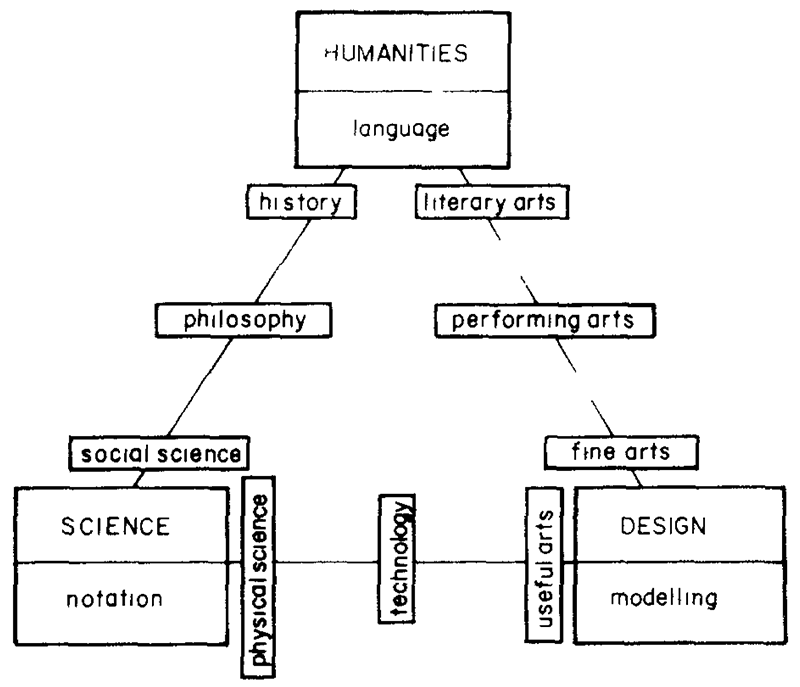
Graphic designers are insecure. This is understandable; design lacks defensible boundaries. It is ubiquitous and absorbent, everywhere and everything. It is never itself, always its subject. It is diffused evenly across our lives to such a low concentration that we often doubt its worth.
In response, we hitch design’s value proposition to other disciplines. We propose how design methods are perfect for solving business problems, how design can match the theoretical richness of architecture, how the line between art and design is blurry, how design is actually an elaborate form of writing, how designers who can’t code aren't worth their salt, and on and on. It makes sense that the practitioners of a fundamentally collaborative discipline would view its worth relatively, but the way design dissolves so completely into our culture lets us define its value more broadly. What if design’s role in the human experience is vast and unique enough to qualify it as a third area of general education—separate from the humanities and sciences?
In 1974, Bruce Archer, a professor at The Royal College of Art, led a program called “Design in General Education.” The program aimed to increase the public’s awareness of design by weaving design activities into the curriculum of secondary schools. Five years later, when the Design Research Society began publishing Design Studies, its international journal for design research, Archer kicked off a series of articles that expanded on his earlier work. Archer observed that while “Science is the collected body of theoretical knowledge based upon observation, measurement, hypothesis and testing, and the Humanities is the collected body of interpretive knowledge based upon contemplation, criticism, evaluation and discourse, the third area is the collected body of practical knowledge based upon sensibility, invention, validation and implementation.” He went on to note, “The repository of knowledge in Science is not only the literature of science but also the analytical skills and the intellectual integrity of which the scientist is the guardian. The repository of knowledge in the Humanities not simply the literature of the humanities but also the discursive skills and the spiritual values of which the scholar is the guardian. In Design, the repository of knowledge is not only the material culture and the contents of the museums but also the executive skills of the doer and maker.”

Bruce Archer's plan for integrating design into curriculum.
Nigel Cross—who, as editor-in-chief of Design Studies, wrote the last article in the series that Archer began—mapped out the gap between specialist education and general education. “The main distinction lies in the difference between the instrumental, or extrinsic, aims that specialist education usually has, and the intrinsic aims that general education must have. It is perfectly acceptable for architectural education, say, to have the instrumental aim of providing competent designers of buildings, but this cannot be an aim of general education. Anita Cross has pointed out that, ‘Since general education is in principle non-technical and non-vocational, design can only achieve parity with other disciplines in general education if it is organized as an area of study which contributes as much to the individual’s self-realization as to preparation for social roles.’”
Roughly 40 years later, design-based instruction has indeed found its way into many K–12 curriculums, a result of the viral popularity of “design thinking” championed at IDEO and Stanford. But “design thinking,” the idea that design-based problem solving can be implemented beyond the design industry, is a diluted version of Archer’s original concept. Solving problems—even a wide variety of them—is still a narrow segment of the human experience. Most K–12 design-based curriculums help students to become more adept at finding solutions, as opposed to helping them to become more adept at finding themselves.
So, it appears that Archer’s idea has fallen short of its aim. This shortfall feeds the aforementioned insecurity so prevalent among designers. It begs the question: Was Archer wrong? Perhaps he overcompensated for his own doubts about design by imagining a future for his craft that was too far-flung. Maybe design is just that and nothing more—a craft.
Before civilization, insecurity helped to keep us vigilant through the vicious night. A lack of ease has also played a part in driving our growth. If we’re confident that everything’s fine the way it is, then there’s no perceived need for change. Designers question everything—including their own convictions. Insecurity is fundamental to the way the design process works. Our inquiries compound, narrowing options until we’re left with something real. Design is not about making something look nice; it’s about helping something to look like itself—a natural vehicle for self-realization. Perhaps our persistent doubt is precisely what tips the craft of design into the realm of intrinsic human knowledge.
